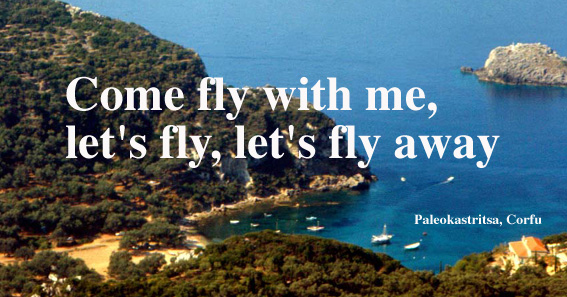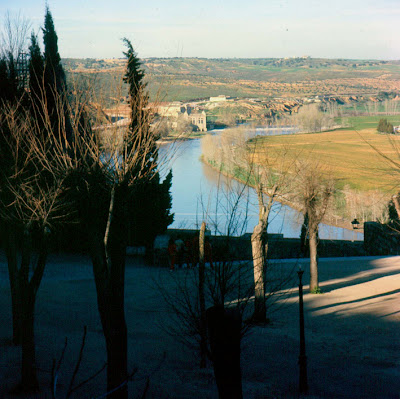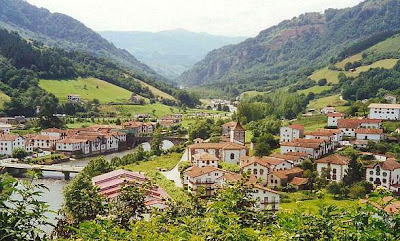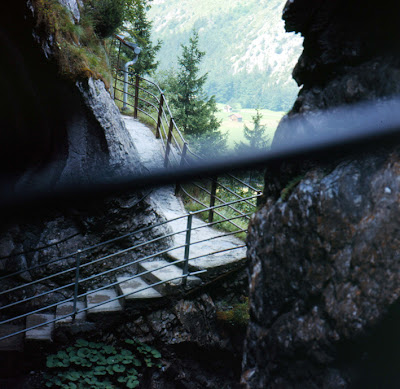Day trips from Madrid
While you are touring the castle, pause to remember one of its most famous occupants, the countess who, while in Peru, was cured of a fever by native medicine prepared from tree bark. She brought the remedy back with her, introducing quinine to Europe. The tree's bark is named chinchona in her honour

While you are touring the castle, pause to remember one of its most famous occupants, the countess who, while in Peru, was cured of a fever by native medicine prepared from tree bark. She brought the remedy back with her, introducing quinine to Europe. The tree's bark is named chinchona in her honour

A horseman walks towards the plaza, Chinchon
Are you visiting Madrid? In the space of one day, you can make a triangular trip to three of my favourite places - to the earthy and atmospheric little town of Chinchon, to the Bourbon elegance of Aranjuez, with its lush gardens and powder-pale palace and, finally, to imperial Toledo, the biscuit-coloured city of El Greco set high on an ochre hill.
I have travelled the triangle in all seasons but if you have a choice, late spring or early fall is best. You can go by train, but if you do so, you'll miss Chinchon, which is a bit off the beaten track. It makes a piquant contrast to the other, grander places. So plan on renting a car for the day. It's just as easy to rent a car in Madrid as it is at home. If the day promises to be hot, take a swimsuit as well as your road map. Both Chinchon and Aranjuez have inviting pools to splash in - and Aranjuez goes one better, with a lazily flowing river, very popular during the summer with the Madrid crowd.
You'll want to leave early, around 9 am, just after the morning rush hour has subsided. You must exit the city on the A3, the main road to Valencia. To get to it, drive down past the Prado museum on the Paseo del Prado until you reach the great Arch of the Emperor Carlos. Here, you swing left, following the sign which says "Valencia". The Valencia road starts out as a multi-laned expressway but soon narrows to a two-lane highway. The city disappears behind you as the sunburned hills of the Castilian plateau surround you.
About thirty minutes down the road, you'll come to a village called Villejo de Salvanes - and the turn-off (it's clearly marked) for Chinchon. The road, though paved, is rougher now, as you head into olive-groved valleys, past vineyards and grazing goats. Chinchon is about thirty minutes from the turn-off. You come upon it quite suddenly, when you reach the top of a rather steep hill; now you must look for and follow the sign which leads you down, through narrow streets, to the Plaza Mayor, or main square.
Chinchon's main square is just what every visitor to Spain hopes for, with multi-tiered balconies, painted dark green, jutting out from whitewashed old buildings which surround the cobblestoned plaza. In the shadows of the lower balconies are bars and shops and cafes; you'll arrive in time to have a mid-morning cup of coffee and, if you're hungry, a plate of fresh-cooked shrimps. If you are here during the bullfight season, the square will be festooned with red and gold banners and the cobblestones will be covered with sand, behind a sturdy wooden barricade. Chinchon is an important town on the bullfight circuit.
Dominating the square and, indeed, the town, is a church of honey-coloured stone, its main facade alive with darting swallows. Use it as a landmark as you start to explore the town. In any event, you won't get lost, for Chinchon is a small place. An hour of relaxed strolling will be enough for sightseeing.
You should first walk up the steep hill from the square to the castle of Chinchon. Here, the aniseed liqueur named for the town and popular all over the country is distilled. The castle is a grey and rugged shell, straddling a hill overlooking the town. The former domain of the counts of Chinchon, it offers you a fine view of La Mancha country: hills that stretch to the horizon, with thousands of neat rows of silver-grey olives. While you are touring the castle (it's open to the public from llam to 4pm) pause to remember one of its most famous occupants, the countess who, while in Peru, was cured of a fever by native medicine prepared from tree bark. She brought the remedy back with her, introducing quinine to Europe. The tree's bark is named chinchona in her honour.
After visiting the castle, wander along the narrow streets and look at the old houses, some painted white, others of weathered stone, often with carved family coat of arms. On such a stroll- actually, I was in search of a lady bullfighter who lived, I had been told, at a certain address - I discovered a bar-restaurant should not miss. From the street, it is quite unpretentious, just a high wall and a glimpse of garden and a sign, Meson Cuevas del Vino. When you enter, the garden becomes a courtyard, green with vines, pink with oleander.
The Meson was, originally, a warehouse where olives were pressed for their oil and grapes for their juice. Today, the place is a series of interconnecting salons, with whitewashed walls, high ceilings, massive wooden beams and the original pressing equipment. A line of huge terracotta wine casks, autographed by visiting celebrities, leads you from one dining room to another- and hundreds of tables welcome the visitor with bright red and white checkered tablecloths. Here, you can sit and munch the ripe black olives of the region and enjoy the pungent chorizo sausage. If you'd care to taste the local vintage in a unique setting, you descend into the caves beneath, where the same huge casks line cobwebbed walls. These dark caverns have been used for wine storage for centuries; the timeworn stone steps, guttering candles and musty dampness contribute to its mysterious ambience. There's a small admission charge to the caves below, which covers the cost of your glass of rioja. It's money well spent.
Aranjuez (pronounced Aran-hweth) is a few miles away, about twenty minutes by car. You'll drive through harshly beautiful rural country, passing on the way a quaintly named village, Villaconejos (Rabbitville) which is just a few mud-coloured houses, a massive mud-coloured church and local women, in black, sitting in the shade. Soon, on the horizon, you'll see an oasis of green, vivid contrast to the brown and yellow hills you have just passed through. Aranjuez is a Royal summer retreat on the River Tagus. If your day has gone according to plan, you'll
arrive here in time for lunch, which means grilled river trout and hot buttered asparagus, followed by delectable local strawberries, preferably at a riverside restaurant. The strawberries of Aranjuez are famous throughout Spain and they're shipped by the carload to Madrid every day during the season.
Before you leave Aranjuez for Toledo, be sure to see the palace and its gardens. Built by Spain's Bourbon kings in the classical style of the early 18th century, it has impressive rooms and salons, a sweeping staircase, Brussels tapestries and a Porcelain Salon that's a fantasy in chinoiserie. The palace is set in a formal garden which adjoins an island garden, the latter somewhat overgrown and gone to seed which seems typical of the country's Royal gardens. But this unkempt quality is charming, in its own way. A small entrance fee is charged for both palace and garden. Allow an hour to see both.
There are two roads from Aranjuez to Toledo - the fast N400 and a narrower, more circuitous route. Better to take the former (it's only 53 kilometres) because you have much to see this afternoon. Toledo is much written about, much visited - and for good reason. You could spend an entire day here, two for that matter. But if your time is limited, it is possible to see the city's most important sights in an afternoon. On my first visit, I did. Be warned, however. If you're driving a rented car, avoid Toledo on a holiday or a Sunday. Parking is impossible.
The city's site is incomparable; it rises from a deep gorge, a great golden vision of stone walls, thrusting steeples and terracotta rooftops. The city is old, going back to Roman times. It is a Royal city, much favoured by the Catholic Monarchs. And it is an ecclesiastical city, seat of the Spanish primate. You should see, first, the cathedral, a Spanish Gothic masterpiece, constructed over three hundred years. This treasury of religious art is renowned for its transparente - a hole in the roof which beams light onto the altar and which is decorated with both fresco and sculpture. To see the work of El Greco, the painter who lived and worked here, go beyond the cathedral (the way is well marked) to the Church of Santo Tomé. Here, in its original setting in the south aisle, is the painter's powerful Burial of the Count of Orgaz. A few steps beyond this church is the Casa del Greco, the 16th century Toledo house which is reputed to be the painter's onetime home. Whether it is or isn't, the layout and design of house and courtyard is most interesting. In the museum here, you can see El Greco's portraits of Christ and the Apostles. And close by is the El Transito synagogue, built in the 14th century, which features handsome mudejar decoration on its upper walls.
In the late afternoon, make your way back towards the Alcazar, which stands on the slope, overlooking the river. This fortress, which harks back to the days of the Cid, dominates the city and has been damaged and restored many times, the last occasion after its siege and shelling during the Spanish Civil War. See it, and the nearby Santa Cruz Museum, if you have time. Originally a hospital, Santa Cruz has a fine facade; among the many fascinating items on display inside is the giant battle pennant of Don Juan of Austria.
As the sun goes down, you'll want to end your day with a leisurely meal - maybe some perfectly roasted suckling pig at one of the city's numerous four star restaurants. Afterwards, you head back to Madrid on the N401 highway. The 71 kilometres pass quickly until, suddenly, out of the darkness, the glow of Madrid rises to greet your return.






















































